![]()
Winter 2014 | ITIC
This study is originally published by The Meir Amit Intelligence and Terrorism Information Center. The study is an overall analysis of ISIS, also known as ISIL, Islamic State (or IS). The study is structured in nine sections,[1] which if read in conjunction with each other, draws a complete picture of ISIS. You can also download the study in PDF format here.
Overview of ISIS’s approach towards the United States and the West (updated to mid-November 2014)
Until the summer of 2014 ISIS focused its activities on expanding the territory under its control in Iraq and Syria. It paid relatively little attention to the United States and other Western countries, limiting itself mainly to attempts to frighten them through the media. The change in ISIS’s policy occurred in the summer of 2014, when the United States identified ISIS as a serious political and security threat and initiated an international campaign against it.
So far, ISIS’s response has been in three stages:
- Stage one, which began at the end of June 2014, was a media campaign to sow fear and prevent the United States from intervening in Iraq to keep it from damaging ISIS. The campaign demonized ISIS in American and Western eyes, sometimes exaggeratedly so.
- Stage two began on August 19, 2014, when ISIS publicly beheaded Western captives abducted in Syria and exposed the executions through the media. So far five hostages (media correspondents and aid workers) have been beheaded, three American and two British. The executioner was a black-clad ISIS operative with a British accent nicknamed “Jihadi John” (who was reportedly wounded in an aerial attack, which did not, however, prevent him from continuing to behead Western hostages). ISIS has other Western captives it may kill. The beheading of the captives demonized ISIS, shocked the world and contributed to America’s change in tactics from pinpoint aerial attacks to a comprehensive campaign.
- Stage three began in the second half of September, when ISIS explicitly called on Muslims around the globe to physically attack Westerners in a variety of ways. In ITIC assessment ISIS supporters have the capacity to answer the call sporadically, since such methods do not necessitate external direction, particular operational skills or extended logistical preparations. The first signs of response from ISIS supporters were seen in Australia, Canada and possibly the United States and elsewhere.
However, ISIS also sent signals to the United States and its coalition that despite the massive aerial attacks it was determined to continue its military operations on the ground. One manifestation is the still ongoing campaign to occupy Ayn al-Arab (Kobanî). Another was the ISIS’s military activity to establish its rule in Al-Anbar province as it moved towards Baghdad (apparently in preparation for the “campaign of Baghdad”).
Psychological warfare (June 2014)
In June 2014 ISIS initiated a scare campaign against United States. It used the social networks to threaten the United States and warn it not to intervene in the events in Iraq:
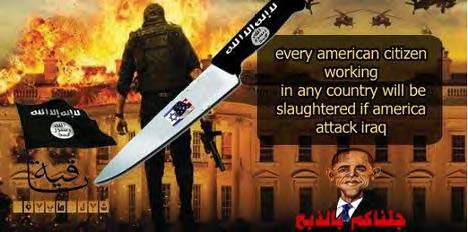
ISIS threat against American citizens. The Arabic reads, “We have come to slaughter you.” The blade of the knife has the Israeli flag, the American flag and the ISIS logo.
ISIS’s Abduction of Western hostages
The terrorist organizations around the globe in general and Al-Qaeda in particular abduct Western hostages. In some instances the objective is ransom, and in others the hostages are executed either in revenge or to sow fear and deterrence. In Syria ISIS and the other organizations abduct hostages, although ISIS is choosy. It abducts Westerners and Arabs it considers high profile, such as correspondents, aid workers, human rights workers, Red Cross workers, etc.
ISIS considers Western hostages, especially correspondents, important assets, especially in view of the international campaign being waged against it.[123] In most instances it abducts Western hostages in planned attacks and in some cases appropriates hostages abducted by other organizations or is supported with information leading to abductions. Westerners are abducted for ransom (several million dollars per hostage) and to sow fear in the West (by beheading captives). ISIS also uses the hostages to manipulate the media (posting videos of captives making speeches dictated by ISIS).
According to an October 26, 2014 article in The New York Times, during the past year at least 23 foreign nationals from 12 countries were abducted by organizations in Syria, especially ISIS. Some of them were sold or transferred to ISIS and held for long periods in an underground prison in Al-Raqqah, ISIS’s “capital city” in Syria. According to the article, in June 2014 seven hostages remained in Al-Raqqah, four Americans and three British subjects. According to former prisoners 15 European hostages were released between March and June 2014 after a ransom of $2 million had been paid for each.[124] According to the Daily Beast website, relying on information from senior members of the American administration, as of November 18, 2014, one hostage, a female American aid worker remained in ISIS captivity (Ynetnews.co.il, November 18, 2014).
The Western countries have two approaches to responding ISIS’s demands: the tough American and British position of refusing to pay ransoms for the hostages because that would encourage more abductions and turn them into desirable targets;[125] and the position of the European and other countries that are prepared to negotiate and pay a ransom for the release of the hostages, either ignoring or downplaying other considerations.
Exploiting abducted correspondents for propaganda: John Cantlie
John Cantlie is a British correspondent and photographer abducted on July 1, 2012. With the aid of the Free Syrian Army he managed to escape and returned to Syria in November 2012, were he was again abducted. Since then he has been displayed in at least six propaganda videos (Bbd.com, October 27, 2014; Mashable.com, October 28, 2014).
In October 2014 ISIS exploited John Cantlie for propaganda purposes to signal the West about the campaign against it and to respond to the information published in the West about the fighting in Ayn al-Arab (Kobanî). On October 13, 2014, ISIS issued a video in which Cantlie “reported” from the battlefield of Kobanî. He said that the jihadists had dug in in preparation for the struggle. He also said that the West had been dragged into a war it could not win against thousands of armed men.
On October 27, 2014, ISIS issued another propaganda video, again of John Cantlie reporting from the battlefield of Kobanî (BBC.com, October 27, 2014). He read a prepared four-minute statement. He said that since the area was closed to the media, the world received information about events in the region from the local Kurdish commanders or from news updates edited by the White House. None of them, he said, told the truth about what was really happening on the ground.
According to Cantlie, ISIS had the upper hand over the Kurds despite the continuing American aerial attacks. He added that the attacks prevented ISIS from using heavy armored vehicles as it would like, and its operatives were forced to use lighter arms in house-to-house fighting. He said ISIS had seized ammunition airdropped by the United States for the Kurdish forces (Mashable.com, October 28, 2014). It is difficult to determine with any degree of certainty whether or not John Cantlie was actually in Kobanî. According to the spokesman for US Headquarters, which coordinates the aerial attacks in the region, there was no way to verify his presence.
Carrying out threats: beheading abducted Western nationals
The roots of beheading in Islam
In the wake of the American aerial attacks, ISIS began beheading Western hostages held in Syria. So far five Western hostages, journalists and aid workers, have been beheaded. Three were American and two were British. Their executions were accompanied by a media campaign to sow fear in the West and deter the United States and the Western countries from continuing their attacks on ISIS (and at the same time to exert pressure on them to negotiate with ISIS either for ransom or the release of terrorists in return for the release of other hostages who appeared in the videos of the beheadings). ISIS also beheaded Syrian and Lebanese soldiers who fell into their hands.
Beheading is an ancient form of execution and not reserved to Islam. Since the earliest times it is known to have a negative psychological influence on the enemy’s fighting spirit while various countries regarded it as a symbol of victory and a means of enforcing law and order.
However, beheading also has deep Islamic roots. The Qur’an calls for the execution of infidels and those who have strayed from the path of Islam with “a strike of the sword on their necks” as the desirable way of killing and also of sowing fear. It is customary to see an Islamic justification for beheading anyone considered an enemy of Islam or an infidel in the interpretation of the first lines of Sura 47 (Muhammad), Verse 4, which states “When you meet the disbelievers in battle, strike them in the neck.” A similar interpretation is given to Sura 8 (Al-Anfal), Verse 12, which states, “I shall put terror into the hearts of the disbelievers — strike about their necks.”[126]
According to the Islamic sources, Abu Jahl, one of Muhammad’s enemies, was beheaded in the Battle of Badr (624 AD). The sources state that Muhammad ordered men sent to kill his rivals. One of those murdered was Ka’b al-Ashraf, a poet who criticized Muhammad, whose severed head was brought to Muhammad. In addition, Muhammad was exclusively responsible for the sentences of death by beheading of 700 Jews from the Bani Qurayza tribe who had been accused of treason.[127]
In addition, ISIS’s use of beheading has “Iraqi” roots, in that it is part of Abu Musab al-Zarqawi’s personal legacy. After the United States entered Iraq he concentrated most of his efforts on suicide bombing attacks in Iraq and on abducting and beheading hostages of various nationalities in front of the camera for propaganda and to induce fear.
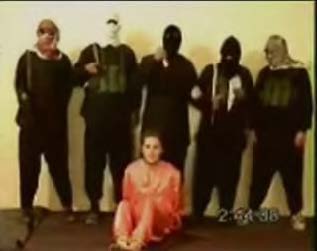
The legacy of Abu Musab al-Zarqawi: American Nicholas Evan Berg, in Iraq on business, before ISIS beheaded him on May 7, 2014. The masked man in the center is apparently Abu Musab al-Zarqawi (Shorouknews.com). Berg’s was the first media-covered beheading, followed by others.
Beheading Syrian soldiers (from a video documenting the beheading of American aid worker Peter Kassig, November 2014)

Left: Knives distributed to ISIS operatives for beheading Syrian soldiers. Right: Leading Syrian soldiers to their death. Some of them may have been pilots. Unknown date.

Left: “Jihadi John” threatens President Obama while preparing to behead Syrian soldiers. According to media reports, two French citizens, two British subjects and two German citizens were identified among the executioners. According to French intelligence sources, a French citizen nicknamed “Abu Abdallah al-Faransi” was identified. A British student named Nasser Muthana was also identified (Ynetnews.co.il, November 18, 2014). According to AP a French citizen named Maxime Hauchard, who had converted to Islam, was identified in the picture. He went to fight in Syria in 2013, and claimed to have participated in the occupation of Mosul, Iraq (AP.org, November 17, 2014). Other ISIS operatives who were identified were Mickael Dos Santos, aka Abu Uthman, a French citizen from a Paris suburb who went to fight in Syria in the fall of 2013; and Abdel Majid Gharmaoui a jihad operative tried in Belgium in absentia (AFP.com, November 19, 2014). Right: ISIS operatives prepare to behead hostages. “Jihadi John” is the masked operative standing fifth from the right.
The beheading of American correspondent James Foley
On August 19, 2014, ISIS’s Al-Furqan Institute issued a video called “A message for America.” It documented the beheading of American correspondent James Foley. Foley, 40, was a freelance correspondent who worked for GlobalPost and Agence France-Presse. He was abducted in Syria on November 22, 2012. The ISIS operative who beheaded him had British citizenship. He claimed the beheading was a response to the American aerial attacks in Iraq. At the end of the video Steven Sotloff was presented as the next candidate for beheading; he would be killed if the Americans did not end their attacks in northern Iraq.
After James Foley was executed a spokesman for the American State Department said that the United States had used air and ground forces in an attempt to extract the hostages in Syria. He said that during the attempt a firefight had developed between American Special Forces and ISIS operatives, killing a number of ISIS operatives and wounding an American soldier. He added that although the Americans had been certain they had sufficient intelligence information, the attempt failed because the hostages were not at the location of the operation. The United States said ISIS was holding at least three more American hostages (Websites of the State Department and the White House, and AP.org, August 22, 2014).
The beheading of American correspondent Steven Joel Sotloff
On September 2, 2014, ISIS issued a video entitled “Another message for America,” which documented the beheading of American correspondent Steven Sotloff. The video warned President Obama that as long as the American aerial attacks continued, it was “only right that we continue to strike the necks of your people ” (Nytimes.com, October 3, 2014). Steven Sotloff, 31, from Florida, freelanced for Time Magazine, Foreign Policy and other media. He was fluent in Arabic and had covered the Middle East for a long time. He and a companion were apparently abducted when they crossed the border from Turkey into Syria on August 4, 2014 (Website of the American State Department, September 3, 2014). British David Cawthorne Haines was presented in the video as the next hostage to be beheaded.
The beheading of British aid worker David Cawthorne Haines
On September 13, 2014, ISIS issued the third video documenting the beheading of a Western hostage, David Cawthorne Haines. The video opened with British Prime Minister David Cameron declaring that Britain would do what was required to support the Kurdish Peshmerga forces in their war against ISIS. It segued to a masked ISIS operative and British aid worker David Cawthorne Haines, who was dressed in an orange prison uniform.
David Cawthorne Haines, 44, was married and had two children. He was born in East Yorkshire and raised in Perthshire, Scotland. Since 1999 he had worked with humanitarian aid agencies around the world, including in Croatia, Libya and South Sudan. He was in Libya during the civil war of 2011. In Syria he worked for a French humanitarian aid organization and was taken hostage in March 2013, along with an Italian companion (Mirror.co.uk, September 13, 2014).
Like the victims in the videos before him, Haines read a political statement written by ISIS. He appealed to Prime Minister Cameron, saying Cameron was responsible for his execution because he had joined the American coalition against the Islamic State. The ISIS operative who had carried out the previous beheadings and spoke fluent English addressed Prime Minister Cameron, telling him Haines had to pay for Cameron’s decision to help the Kurdish forces. At the end of the video Alan Henning was presented as the next hostage who would be killed unless Britain left the anti-Islamic State coalition.
The beheading of British aid worker Alan Henning
On October 24, 2014, ISIS issued its fourth video, 11 minutes long, documenting the beheading of British aid worker Alan Henning. He said he was paying the price for the decision to attack ISIS.
Alan Henning was 47, a taxi driver from Manchester, Britain. He took time off from his job to go to Syria to drive trucks transporting humanitarian aid. According to his friends he had never been involved in politics or religious issues. At the end of 2013 he joined an aid delegation in northern Syria. He was abducted in December 2013 about half an hour after he crossed the border from Turkey into Syria. During his last weeks leaders of the Muslim community in Britain called for his release (Telegraph.co.uk, October 3, 2014). The video also presented American aid worker Peter Kassig as the next victim.
The beheading of American aid worker Peter Kassig
On November 16, 2014, ISIS issued a 15-minute video documenting the beheading of Peter Kassig. It boasted of ISIS’s jihadi capabilities and accused Kassig of serving as a soldier against Muslims in Iraq. According to the video it was being filmed in the northern Syrian city of Dabiq, which according to Islamic tradition is supposed to be the site of a decisive battle between Muslims and Christians, which the Muslims will win.
Peter Edward Kassig, 26, from Indiana, converted to Islam and changed his name to Abd al-Rahman. He went to Turkey in September 2013 as part of a medical team helping Syrian civilians who had fled the Syrian civil war, providing them with humanitarian aid. He was based in Lebanon during the months before he was captured. He was abducted by ISIS operatives a year ago when he was en route to Syria.
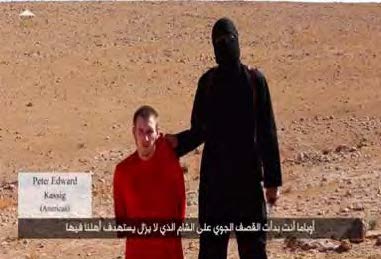
Peter Kassig before he is beheaded (From an Al-Furqan[128] video, Shorouknews.com)
ISIS’s call to kill Westerners and the initial response (updated to the end of October 2014)
Overview
On September 21, 2014, an ISIS spokesman called on the organization’s sympathizers around the globe to kill Western citizens. In ITIC assessment, various terrorist attacks carried out or prevented since then were motivated by the desire of jihadists to show solidarity with ISIS and support it (including those who did not belong to it or publicly sympathize).
The attacks and attempted attacks were apparently not planned or directed by ISIS or another global jihad network. They were spontaneous local initiatives carried out mainly by “lone wolf” jihadists from Western countries belonging to the anti-ISIS coalition, primarily the United States. Some of them were Muslims who had become radicalized and others were converts. In some cases the lone wolf terrorists may have been supported by local global jihad sympathizers. As the campaign of the Americans and their allies against ISIS continues, more attacks may be attempted.
ISIS’s call to kill Westerners
On September 21, 2014, the Al-Furqan Institute issued a 42-minute recording of ISIS spokesman Abu Muhammad al-Adnani. He called on ISIS’s supporters all over the world to kill Western citizens, especially Frenchmen and Americans in retaliation for the campaign against ISIS. He emphasized that every ISIS supporter had to act, each according to his ability. Every Muslim, he said, could choose his own method as long as he attacked “the infidels” and helped ISIS defend itself against the campaign being waged by the “Crusader” Western countries and their Arab “agents.”
He listed ways that could be used to attack American and French infidels, saying, “The best thing to do would be to kill any French or American infidel or any of their allies. If you cannot [detonate] a bomb or [fire] a bullet, arrange to meet alone with a French or an American infidel and bash his skull in with a rock, slaughter him with a knife, run him over with our car, throw him off a cliff, strangle him or inject him with poison. Don’t stand by, helpless and abject… If you are incapable of this, burn down his house, his car, his business or his field. And if you are incapable even of this — then spit in his face. And if you refuse [to do] this while your bothers are being bombed and killed and their lives and property are under attack everywhere, then examine your faith…” (MEMRI.org, September 22, 2014).
In a video called “Message from the jihad fighter (mujahid),” uploaded in October 2014, the British ISIS operative called “the British Sayid” appears. He says to all the “brothers in the United Kingdom who cannot join the jihad in Syria, you are living in the west… You are blessed that you can cause terror in the hearts of the infidels, right in the center of all that heresy and of all that polytheism. You can cause terror right from within…” (MEMRI.org, October 6, 2014).
Australia: Preventing beheadings in Sydney
Australia is one of the countries that declared it would join the coalition supporting the American campaign against ISIS. The Australian air force reportedly deployed in the Middle East and its planes began flying in the skies over Iraq on October 1. 2014. Thus Australia became a potential terrorist target for jihadists who supported or were affiliated with ISIS.
On October 1, 2014, Australian Prime Minister Tony Abbott told Parliament there were at least 60 Australians fighting in the ranks of the terrorist organizations and at least 100 Australians had supported them with funds and the logistics necessary to recruit fighters and send them to the Middle East (Website of the Australian government, October 1, 2014). The Australian authorities are aware of the dangers of terrorism posed by the return of the veterans of the fighting in Syria and Iraq.[129]
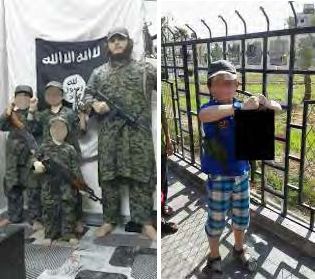
Left: Picture posted by Australian ISIS operative Khaled Sharrouf, taken with his three children. They all hold weapons; the ISIS flag is in the background (Twitter, August 12, 2014). Right: Khaled Sharrouf’s seven year-old son holds the head of a Syrian soldier (blacked out). The picture was taken in Al-Raqqah and posted by his father (Twitter, August 12, 2014)
On September 18, 2014, the Australian security forces detained 15 jihadist operatives in Sydney following intelligence that ISIS was planning terrorist attacks in Australia. According to the indictment of Omarjan Azari, 22, he was involved in a plan to randomly kill people to scare the Australian population. According to Australian Prime Minister Tony Abbott the detainees planned to publicly and randomly behead people on the streets of Sydney (AP.org, September 18, 2014).
Canada: Vehicular and shooting attacks
Vehicular attack
On September 20, 2014, a Canadian soldier in Quebec was run over and killed and another soldier was wounded. The attacker was Martin Couture-Rouleau, 25, who had converted to Islam the previous year. He aimed his car directly at the two soldiers. He was shot and killed by police after a chase of several kilometers. According to one of his friends, he dreamed of dying as a shaheed.
Martin Couture-Rouleau was on a list of 90 radical Muslims who were being monitored by the Canadian security forces, preventing them from leaving the country and joining jihadi organizations (in Syria). The Canadian media reported that on Couture-Rouleau’s Facebook page were an ISIS flag and expressions of solidarity with it. The Canadian prime minister described him as a terrorist inspired by ISIS.
Shooting attack
On September 22, 2014, a Canadian soldier who stood guard at Canada’s War Memorial (near the Parliament building in Ottawa) was shot to death. The shooter then entered the building and fired dozens of bullets. He was shot and killed by the head of Parliament security (whose resourcefulness turned him into a national hero).
The shooter was Michael Zehaf-Bibeau, 32, born in Montreal, who had a criminal record. His father was Libyan and his mother, an official in the Canadian administration, was of European extraction. In recent years he converted to Islam and became a religious extremist. He apparently planned to fly to Syria, but his passport was confiscated by the Canadian authorities because he had been designated as a high-level security risk.
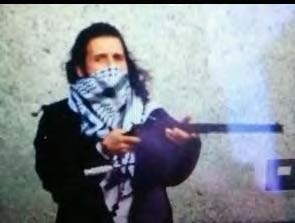
Michael Zehaf-Bibeau, who killed the Canadian soldier and carried out the shooting attack in the Canadian Parliament (Facebook page opened in his memory).
Postings on the social networks from ISIS sympathizers praised the shooting attack in Ottawa and expressed satisfaction. One tweeter claimed that “the attack was a response to the call from ISIS spokesman Abu Muhammad al-Adnani to ISIS supporters to carry out attacks in Western countries” (MEMRI.org, October 23, 2014).
The United States: Policeman attacked with a hatchet in Queens, New York
On the afternoon of October 23, 2014, a man armed with a hatchet attacked a group of four policemen on a busy street in Jamaica, Queens. He brought the hatchet down on the head of one, critically wounding him. Another policeman was wounded in the arm. A 29 year-old woman was hit by a stray police bullet.[130]
The attacker, Zale Thompson, 32, was shot to death by police (Dailymail.co.uk). He had converted to Islam two years previously and became an extremist. He reportedly hated policemen and white people. His Facebook page had a picture of a man wearing Middle Eastern clothes with writing in Arabic. He also posted his loathing for the West on the social networks and visited websites affiliated with extremist Islamist groups. According to the police, he was working alone. The police are investigating whether the attack was carried out as a response to ISIS’s call to attack American citizens (Dailymail.co.uk, October 23, 2014).
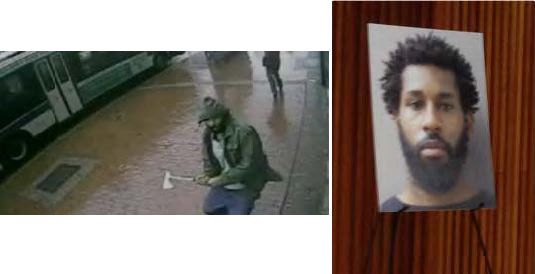
Left: Surveillance footage of the attack in Queens, released by the police department (Twitter account of CBS-TV reporter Tony Aiello). Right: Picture of the Queens attacker, released by the police department (Twitter account of CBS-TV reporter Aiello).
Austria: Bombs in busy train station in Vienna
On October 30, 2014, a 14 year-old boy was detained on suspicion of planning to place IEDs in crowded locations in Vienna. ISIS reportedly offered the boy $25,000 to carry out the attacks. According to the Austrian media the boy was Mertkan G., the son of a Turkish immigrant. Other young men were recruited to carry out similar attacks (according to a different account, the boy acted alone) (Telegraph.co.uk, October 30, 2014).
Among the locations in Vienna where the IEDs were to be placed was Vienna’s Westbanhof Station, one of city’s busiest train stations, through which an estimated 40,000 people pass every day. According to the Austrian media, the boy planned to use websites to learn how to manufacture an IED and where to purchase the necessary materials. According to one report, he said he planned to go to Syria to fight in the ranks of the jihadists, and carrying out the attack in Vienna would be a kind of “ticket” to join.
![]()
[1] Links to all other nine sections:
You can read the overview — “ISIS: Portrait of a Jihadi Terrorist Organization” — here.
You can read section 1 — “The historical roots and stages in the development of ISIS” — here.
You can read section 2 — “ISIS’s ideology and vision, and their implementation” — here.
You can read section 3 — “ISIS’s military achievements in Iraq in the summer of 2014 and the establishment of its governmental systems” — here.
You can read section 4 — “ISIS establishes itself in eastern and northern Syria” — here.
You can read section 5 — “ISIS’s capabilities: the number of its operatives, control system, military strength, leadership, allies and financial capabilities” — here.
You can read section 6 — “Exporting terrorism and subversion to the West and the Arab world” — here.
You can read section 7 — “ISIS’s propaganda machine” — here.
You can read section 8 — “The American campaign against ISIS” — here.
![]()
Notes:
[123] The FBI sent a bulletin warning of ISIS’s to abduct correspondents. The FBI received credible information that ISIS was planning to abduct correspondents, who were considered “desirable targets.” The FBI also based its assessment on open source statements and international postings stating that American media personnel were legitimate targets for abduction in retribution for the American-led aerial attacks in Iraq and Syria (Washingtonpost.com, October 23, 2014).
[124] A jihadi forum posted an announcement from abducted British correspondent John Cantlie (See below). In it he said that 16 prisoners from six countries had been released after negotiations with the Islamic State. He mentioned Germany, France, Denmark and Spain. However, he added, the United States and Britain refused to negotiate with the Islamic State. He said ISIS demanded the United States and Britain release Muslim prisoners and transfer them to the Islamic Caliphate in return for the Western prisoners (Al-Furqan Institute, October 25, 2014). The announcement was apparently intended to exert pressure on the United States and Britain to negotiate the terms of the hostages’ release with ISIS.
[125] It was recently reported that President Obama asked for a reexamination of American policy regarding negotiations for the release of American hostages held by terrorist organizations. His request was made after criticism of how the administration functioned in dealing the issue of with hostages held by ISIS. The families of the hostages who were murdered complained that the White House had warned them not to pay the ransom demanded by ISIS, and that if they did they would be charged with committing a crime. Other families complained that the administration did not monitor information they provided about where the hostages might be held. It was also reported that there were differences of opinion between the White House/State Department and the FBI, which was in favor of paying ransoms (Haaretz.co.il, November 19, 2014, quoting the Daily Beast).
[126] The Qur’an, translated by M.A.S. Abdel Haleem, Oxford World’s Classics, 2005.
[127] Reuven Berko, “The History of Violence,” Israelhayom.com, September 5, 2014.
[128] An ISIS media outlet.
[129] For further information see the February 2, 2014 bulletin “Foreign fighters from Western countries in the ranks of the rebel organizations affiliated with Al-Qaeda and the global jihad in Syria.”



 RSS
RSS

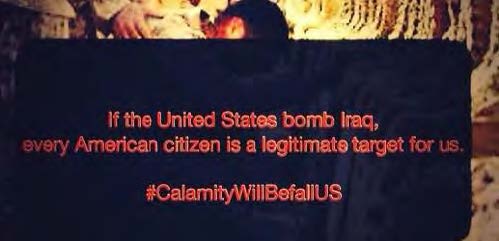

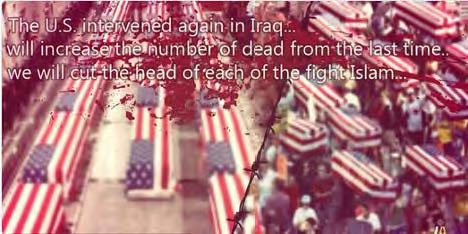
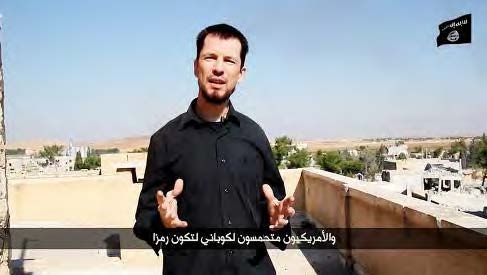
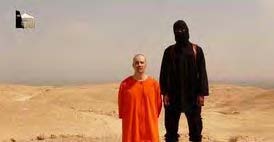
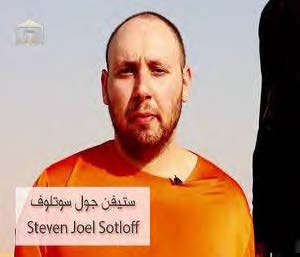
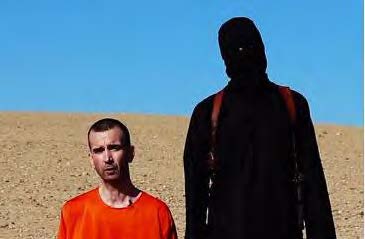
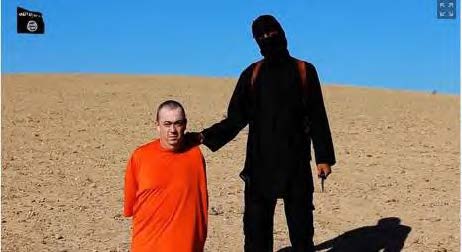


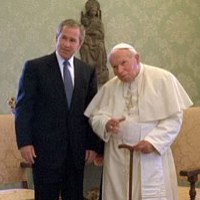


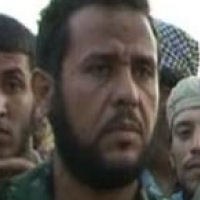










Latest Comments
Hello Mike, Thank you for your positive feedback to the article. I felt there wasn’t too much critical analysis of ...
Thanks for this considered and well constructed article. A follow up article on the manner in which the editorial contro...
THE CLUELESSNESS OF CLAIMING THAT OBAMA'S MIDDLE EAST POLICIES WERE A FAILURE CANNOT BE FURTHER FROM THE TRUTH, WHAT THE...
As long as Obama is the president of the usa do not trust the us government......
Thank you for an good read....